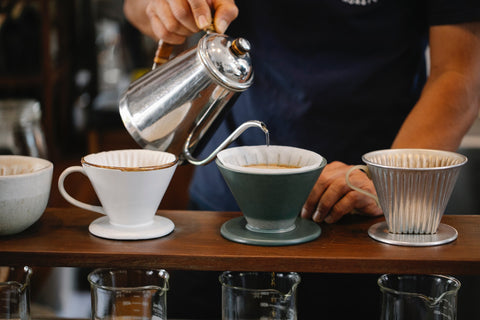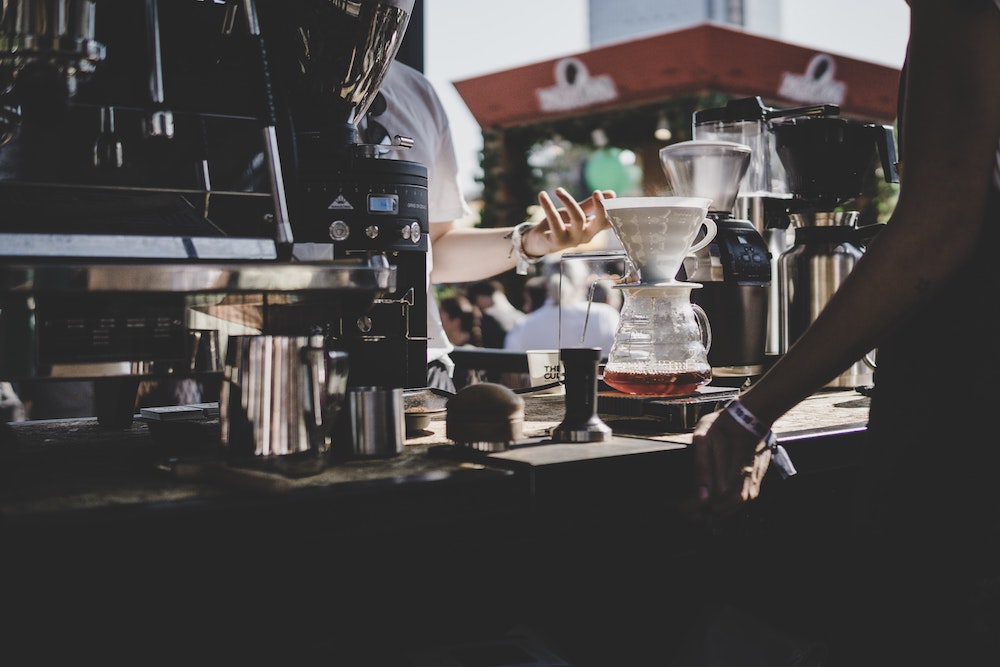Finding the right brewing method for your home coffee set-up or coffee bar can be tricky. To help you decide what’s right for your coffee brewing needs, we’ve broken down the key differences between pour over and batch brew, plus the pros and cons.
We talked to our very own coffee bar manager, Vincent Grimaldi, to get a better understanding of these differences and how you can choose between the two methods. Keep reading to learn more.

What is pour over coffee?
Pour over coffee has been around for quite some time, but has recently enjoyed renewed popularity thanks to the third wave of coffee.
This brewing method involves pouring hot water over coffee grounds in a filter held by a pour over dripper. The hot water then moves through the grounds and into a server or cup below. Unlike the French press, which uses immersion to extract flavor from coffee, pour over is what we call a “percolation” brewing method.
Pour over is sometimes also called hand brewing or manual brewing because of the way it’s prepared. It can be a little bit more intricate than other methods, but provides a balanced, flavorful cup of coffee.
Popular manual brewers include the Hario V60 and Chemex. The Hario V60 is a cone-shaped brewer with angled walls and beveling that help to achieve even extraction. The Chemex, meanwhile, is a classic one-piece brewer and carafe that allows you to make larger batches.

What is batch brew?
In contrast with pour over, batch brew is a popular method to automatically brew large quantities of coffee. It is also a percolation brewing method, and has been popular across the country for years as diner-style drip coffee.
However, these days, batch brewers can produce much higher-quality coffee than you might think.
First and foremost, once set up properly, this method removes human error from the equation. Once the machine is dialed in, Vincent says the quality can be replicated batch after batch.
“It can still be dialed in, so the coffee can have an exceptional taste and can be a proper representation of itself,” he notes.
Ultimately, batch brew is quick, convenient, and requires minimal training to perfect. Once brewed, the coffee can then easily be stored and then served from a carafe. This usually works well for high-volume cafés wanting to avoid brewing coffee cup-by-cup.

Automation vs control
Batch brew is automated, so it’s naturally the more convenient method. At a basic level, it’s essentially a mechanized version of pour over. The brewer handles all of the extraction variables you’d normally have to manage with pour over, leaving less room for human error.
Conversely, Vincent explains that the benefit of pour over is that it gives you absolute control over every variable when brewing a cup of coffee.
“You determine the ratio, brew time, and pouring technique for each cup,” he says. “Pour over allows you to make quick, efficient adjustments on the fly.”
Meanwhile, for batch brewers, you can usually easily make adjustments to the brew ratio and grind. However, Vincent adds that more complex adjustments might require more in-depth knowledge of the machines’ inner workings.
Preparation
Vincent explains that the preparation for batch brew and pour over should be fairly similar, as batch brew is effectively just “scaled up” pour over. However, it’s important to note that grind size is important to achieving a well-balanced cup.
Too coarse a grind will lead to a sour, acidic, and underextracted cup. On the other hand, a grind that’s too fine will give the coffee a bitter or dirty taste.
As a general rule, you should use a coarser grind size for batch brew than pour over, as it steeps for longer and takes longer to brew. A medium grind size is the most common option for batch brew, with a similar texture to smooth sand.
For conical pour over brewers – like the Hario V60 – use a medium-fine grind similar to table salt. For the Chemex, you’ll want to go slightly coarser.

Flavor differences
When it comes to comparing the flavors each brewing method can achieve, Vincent says there are a lot of variables to consider.
“All things being equal, you should be able to get pretty close,” he says. “A coffee bar that can invest in modern, high-end batch brewers should be pretty on par with what a professional and focused barista can do with pour over.”
However, depending on the quality of your batch brewer, you could get a very different final product with each of the two methods.
An entry-level batch brewer can still make a tasty cup of coffee, but may produce a bolder and more full-bodied brew that is less refined.
Pour over, meanwhile, yields flavor profiles with a bit more clarity and balance, since the extraction variables can be tailored by hand. This method is great for single origin coffees where you want to highlight a specific characteristic, for instance.
Freshness
Coffee that’s left to stand in a batch brewer or urn isn’t as fresh as brewing cup by cup. While you’ll be able to serve more customers from a batch brewer, the coffee won’t be as vibrant if it sits for a few hours.
Ultimately, pour over is the best way to get the freshest cup. If the coffee is freshly ground and brewed shortly afterward, you’ll get a fresh, delicious cup with every brew.

Differing skill levels
Batch brewers are usually easier to use and more accessible than manual brewing. Once the settings have been dialed in, it’s easy to train someone to replicate the process and get similar quality every time.
Meanwhile, pour over is more hands-on and gives you control over all extraction variables, but even small shifts in technique can detract from or enhance your final coffee product.
Cleaning
Batch brewers are harder to clean than pour over brewers, purely because there are more parts that need to be maintained. This calls for a more complex cleaning regimen to make sure coffee oils don’t accumulate and affect the final cup profile.
Without cleaning, batch brewers tend to retain stale off-flavors and give the coffee a murky or skewed taste.
Manual brewers are much easier to clean as they tend to be more compact and have little to no complex internal parts that need attention. However, this doesn’t mean that cleaning this equipment is any less important.

Which is better?
Pour over coffee might be preferable if you’re more experienced and have the time to dedicate to learning the art of the method. If you’re willing to invest the time in learning, you can brew high-quality coffee at home at a minimal cost. It’s also the better option if you’re just making a cup or two.
Batch brew, meanwhile, is much more convenient and helpful if you’re serving lots of filter coffee. It’s still a great option for brewing specialty coffee, but lacks the same level of control and sustained freshness.
Overall, Vincent recommends that coffee bars invest in both methods.
“A barista should, in my opinion, be emotionally invested in crafting pour over coffee,” he says. “At the same time, every barista I know feels comfort when supported by consistent, reliable batch brewers.”

At the end of the day, your choice between these two popular brewing methods comes down to the skill of the person making the coffee and your specific needs.
Both options have the potential to make superb coffee, but each is suitable for a different purpose. Ultimately, it’s worthwhile becoming familiar with both methods. You never know when you’ll need to use either!





